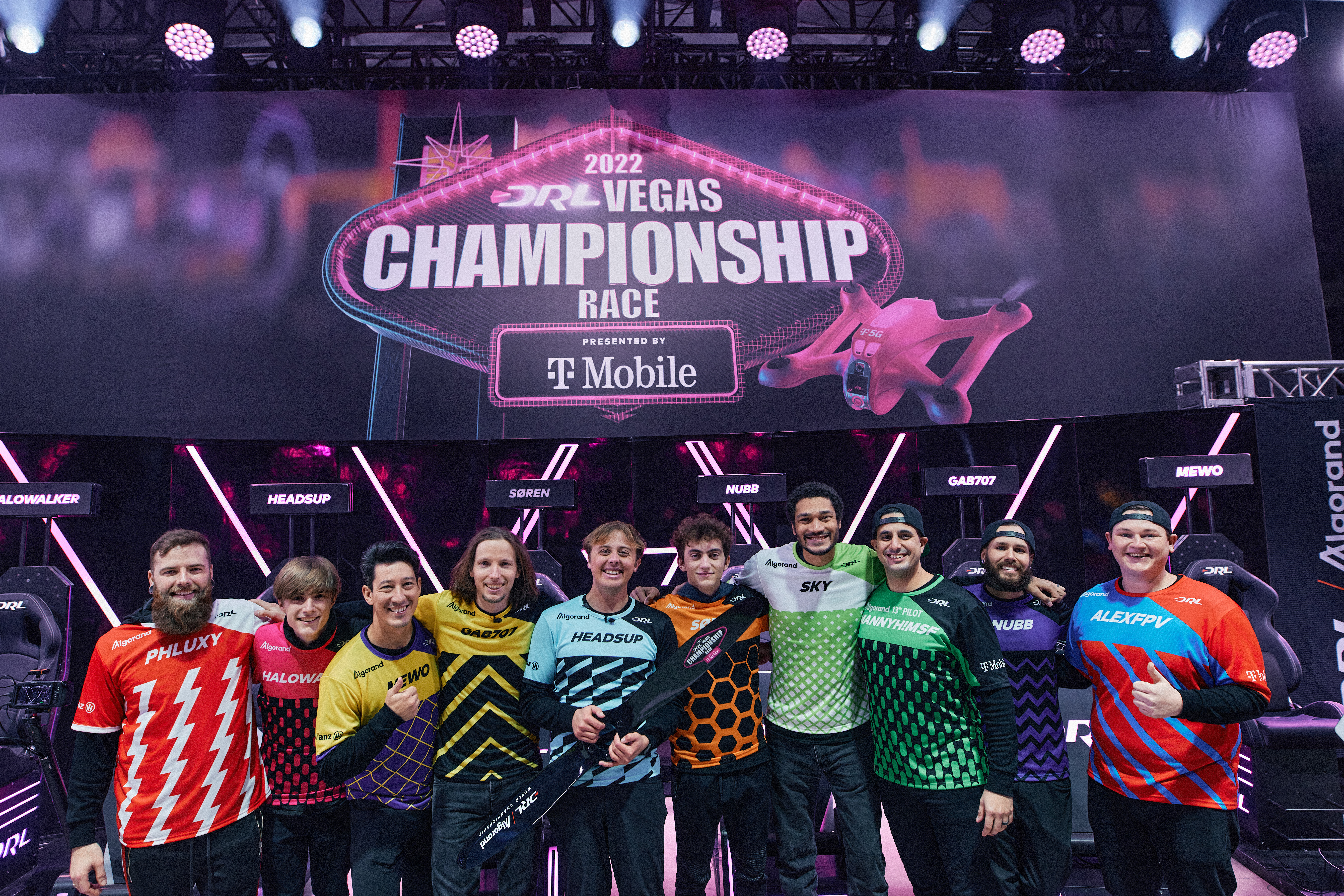



image courtesy Drone Racing League
Two-time Drone Racing League Champion ‘Headsup’ reflects on career in the sport
By Jim Magill
All images courtesy Drone Racing League, used with permission.
Piloting a high-speed, highly maneuverable first-person view (FPV) drone through a course of brightly colored obstacles and gates, “you truly think that you’re in the front seat of this thing,” two-time Drone Racing League (DRL) champion Evan Turner said in an interview.
Turner, who also goes by his racing name of “Headsup,” won the title February 20, at the 2021-22 Algorand Drone Racing League Vegas championship race in Las Vegas. The final heat, known as the Golden Heat, of the racing tournament pitted Turner against DRL’s longest reigning pilot, Gabriel “Gab707” Kocher.


Image courtesy Drone Racing League
The DRL, the premier global professional drone racing league, challenges elite pilots to fly custom-built racing drones traveling at speeds of up to 90 mph. Pilots compete during a multi-city tour in a series of virtual and physical competitions.
For Turner, who celebrated his 19th birthday last month, re-winning his DLR championship is the high point of his young life, and caps a career of piloting unmanned aerial vehicles that began at a very young age.
“I have flown something that flies in remote control since I was 6 years old, alongside my dad,” he recalled. “When my Dad came home from work and I’d come home from school, I’d get on the simulator. This was flying remote-control planes, before drones even existed.”
After several years, as technologically sophisticated drones began taking over the hobbyist market for unmanned aircraft, the father-son duo switched to the newer kind of unmanned aerial vehicles. Turner said the switch was also partly the result of his mastery of R-C aircraft exceeding that of his father.
“My dad would get frustrated that I was better than him,” he said. “About the time when I was 12 years old, my Dad got into drones, because he wanted to be better than me at something.”
Turning professional at 16
Turner began competing in amateur drone races at the age of 14 and joined the DRL at 16. “DRL was pushing to find the best pilots in the world. I was kind of next in line to take my shot at it.”
Competing at the level of the DRL requires a combination of skill and strategy. Unlike in auto racing, where competing teams design and build their own vehicles, DRL racers all operate the same make and model of drone, the custom-built DRL Racer4.


image courtesy Drone Racing League
“The DRL has done all the research and development,” Turner said. “They have the DRL tech ops crew. They’re the people behind the scenes, maintaining all the drones, setting them all up for the pilots beforehand.”
This uniformity in the equipment levels the playing field to where victory is achieved solely based on the skill of the pilot. “For all the pilots, what determines whether you get to the finish gate first or last is based off of how you fly the drone,” Turner said. “It’s based on: did you fly better than the next guy?”
The strategic aspect of drone racing comprises both physical and mental components, he said.
“There’s the actual strategic side, where you’re trying to compete at your best level within the rules, and you have to finish first in the most races,” he said.
“Then there’s this whole other side and that is the mental game,” Turner said. “At the end of the day we’re all competitors and we really want to win. What it takes is a little bit of trash talk; you kind of have to get into other people’s heads. That’s truly a strategy that’s utilized by all of the pilots.”
One aspect of the metal strategy is the ability to maintain a poker face, appearing to be calm, cool and collected, while guiding flying vehicles around a complicated course at breathtaking speeds. However, while the pilots might appear to be maintaining an unruffled exterior, viewers watching the competition at home are able to see the true physiological effect of the races thanks to a platform provided by drone hardware and software company DraganFly, which displays competitors’ heart rates in real time.
“It may look like we’re just sitting there on the stage, holding our remotes with our goggles on, but our heart rate is 115-120 beats per minute. Our hearts are beating so fast because we’re so nervous, so uptight about everything that’s going on,” Turner said.


image courtesy Drone Racing League
Advice for next generation of champion racers
His championship win has brought Turner a degree of fame that the 19-year-old could only dream about when he began his professional racing career.
“I was at a Mexican restaurant and all of a sudden, I came up on TV. It was so cool for DRL to put drone racing and aviation technology out to the public at such a large scale,” he said.
Turner encouraged younger fans of the sport to get involved in drone racing themselves.
“I think drone racing is important,” he said. “I’m not going to go out and tell everybody that they need to be a professional drone racer. That’s difficult and requires a lot of work and time that some people don’t have. But I do think is drone racing should be a part of their lives.”
He said working with drones can teach young people problem-solving skills as they try to build and maintain aerial vehicles that can fly faster and take sharper corners.
“If they can think about drone racing or drone technology as something that’s fun for them, the possibilities are endless,” he said. “Even if they’re not the best drone racers, if they can take those skills that they learned from drone racing and apply them to whatever they do in life, they’re going to go so far and they’ll have such an advantage.”
Read more about drone racing:

 Jim Magill is a Houston-based writer with almost a quarter-century of experience covering technical and economic developments in the oil and gas industry. After retiring in December 2019 as a senior editor with S&P Global Platts, Jim began writing about emerging technologies, such as artificial intelligence, robots and drones, and the ways in which they’re contributing to our society. In addition to DroneLife, Jim is a contributor to Forbes.com and his work has appeared in the Houston Chronicle, U.S. News & World Report, and Unmanned Systems, a publication of the Association for Unmanned Vehicle Systems International.
Jim Magill is a Houston-based writer with almost a quarter-century of experience covering technical and economic developments in the oil and gas industry. After retiring in December 2019 as a senior editor with S&P Global Platts, Jim began writing about emerging technologies, such as artificial intelligence, robots and drones, and the ways in which they’re contributing to our society. In addition to DroneLife, Jim is a contributor to Forbes.com and his work has appeared in the Houston Chronicle, U.S. News & World Report, and Unmanned Systems, a publication of the Association for Unmanned Vehicle Systems International.
Miriam McNabb is the Editor-in-Chief of DRONELIFE and CEO of JobForDrones, a professional drone services marketplace, and a fascinated observer of the emerging drone industry and the regulatory environment for drones. Miriam has penned over 3,000 articles focused on the commercial drone space and is an international speaker and recognized figure in the industry. Miriam has a degree from the University of Chicago and over 20 years of experience in high tech sales and marketing for new technologies.
For drone industry consulting or writing, Email Miriam.
TWITTER:@spaldingbarker
Subscribe to DroneLife here.





Related Posts
Terra Drone Corporation Expands into U.S. Market through Strategic Investment in Aloft Technologies
Enhancing Photogrammetry Accuracy with Advanced GCPs Integration by SimActive and CompassData
Digital Weather Integration and Scalability of Drone as First Responder (DFR) Programs